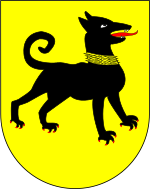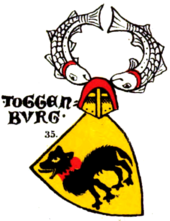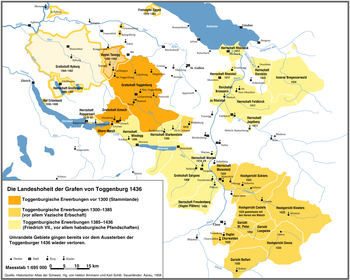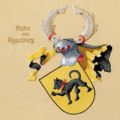Toggenburger
|
Territory in the Holy Roman Empire |
|
|---|---|
| County of Toggenburg (1209–1436) | |
| coat of arms | |

|
|
| map | |
| The state sovereignty of the Toggenburgs until 1436
|
|
| Arose from | Baron Toggenburg (until 1209) |
| Form of rule | county |
| Ruler / government | Count of Toggenburg |
| Today's region / s | CH-ZH, CH-GR, CH-SG, CH-SZ, CH-TG, AT-8
|
| Reichskreis | circular |
| Capitals / residences | Lichtensteig , Feldkirch |
| Denomination / Religions | Roman Catholic |
| Language / n |
German
|
| Incorporated into | Dissolution 1436, division
|


The Toggenburgs were an aristocratic family from eastern Switzerland who belonged to the imperial upper nobility . The focus of the County of Toggenburg was on the landscape that today bears its name as « Toggenburg ».
The title of count has been documented since 1209. The family's ancestral home was Alt-Toggenburg , now a ruin in the municipality of Kirchberg , Canton St. Gallen . Shortly before its extinction in the male line in 1436, the family was able to establish one of the largest territorial lords between the Confederation and the Habsburgs through inheritance and pledges. Because of the controversial division of the Toggenburg heritage, the so-called Old Zurich War broke out between the federal locations of Zurich, Schwyz and Glarus .
history
The originally noble free , later promoted to barons and counts of Toggenburg have been documented since 1044. The name probably comes from the Alemannic dokko , which means something like "the outstanding". The Toggenburg family must have had special rights and significant property from an early age, because the establishment of their main festivals, the old Toggenburg in 10/11. Century, was extraordinarily defensive for its time. It was on a hill near Fischingen . Today the pilgrimage church of Saint Idda of Toggenburg (St. Iddaburg) is located there . The castle was located in the center of the Toggenburg property in today's Alttoggenburg, Hinterthurgau and the Zurich Oberland. Another Toggenburg castle from this period is Lütisburg , mentioned in 1214 as Liutinsburch and probably founded by a Liuto from Toggenburg. The towns of Lichtensteig and Wil SG are probably founded by the Toggenburgers.
Alt-Toggenburg (Iddaberg)
Between 1044 and 1209, no precise classification of the known family members could be made in a family tree. The development of the dominion is also unclear. Because of landlord and court conflicts, the Toggenburgers came into conflict with the St. Gallen monastery , which owned by far the largest landlord in eastern Switzerland. For example, a Diethelm von Toggenburg was in a feud with Abbot Ulrich von St. Gallen around 1083 . During the investiture controversy, the noble families of Toggenburg, Kyburg and the Duke of Zähringen , who are wealthy in what is now Switzerland, sided with the Pope together with the Abbot of Reichenau , while the St. Gallen Monastery stood on the side of the German king . Volknand I of Toggenburg was killed during this conflict in the fight for the Bernegg fortress built over the city of St. Gallen in 1081.
The Benedictine monastery Fischingen , founded in 1138, was supported by the Toggenburgers, as they held the bailiwick over the monastery. Saint Idda of Toggenburg , who was probably married to a Toggenburg count, is buried in a chapel near Fischingen Monastery. Furthermore, the Toggenburgs held the bailiwick of the St. Johann monastery in the Thur Valley until 1226 . Diethelm V. finally donated the Johanniterkommende Bubikon in 1192 , probably after participating in the third crusade .
Since 1209 the title of Count for Diethelm VI. (as "Count" Diethelm I.) of Toggenburg documented. He was married to Guota von Rapperswil , who brought Uznach and the Upper March with Grynau into the marriage. After his son Diethelm II murdered his younger brother Friedrich in 1226, Diethelm I. transferred Wil SG and the old Toggenburg to the monastery of St. Gallen and founded the Johanniterkommende Tobel in today's Canton of Thurgau in 1228 . Because of this, a long-standing feud broke out between the sons of Diethelm II and the St. Gallen monastery , but the possessions remained with St. Gallen. In the course of this conflict, the Neu-Toggenburg Castle was built near Lichtensteig. During the feud between Count Rudolf von Habsburg and Abbot Wilhelm von St. Gallen over Wil and Schwarzenbach , the Toggenburgers tried again in vain to regain possession of Wil. Even that of Friedrich III. aspired acquisition of Winterthur failed. The alleged destruction of Uznaberg Castle in 1267 or 1268 by Zurich troops under the command of Rudolf von Habsburg is not documented.
Count Kraft III. concluded a castle right with the city of Zurich in 1327 and initiated the last phase in the history of the House of Toggenburg, in which the counts tried to take a profitable middle position between the Confederation and Habsburg . Force III. fell in 1337 in the battle of Grynau between Zurich and Habsburg as captain of the Zurich troops. His brother Friedrich V then married Kunigunde von Vaz in 1323 . Through the inheritance of the House of Vaz and a skilful territorial policy, Frederick V expanded the Toggenburg's holdings considerably ( Wildenburg , 1313; Vazische inheritance 1333: Maienfeld , Windegg , Marschlins Castle , Zizers , Igis , Schiers , Castels Castle , Davos , Belfort , Vogtei Churwalden ; Erlenbach and Herrliberg 1335; Rüdberg , Bütschwil , Vogtei Peterzell 1340; St. Peter and Langwies , 1363). Later came the lordships of Greifensee (1369) and Rapperswil SG (pledge from Habsburg, 1378) and the county of Kyburg with Winterthur (1384).
Count Friedrich VII concluded an alliance with the House of Habsburg, which initially set limits to further expansion in Eastern Switzerland, as the jointly waged war against the Glarus valley in 1388 ended in disaster: the knightly army of Habsburg nobles and vassals led by Friedrich's uncle Donat was destroyed by the Glarnern in the battle of Näfels on April 9, 1388. By marrying Elisabeth von Matsch , Friedrich managed to win the longstanding conflict between the two families over the possession of the central Prättigau around Castels.
The property was divided between Donat and Frederick VII in 1394. Donat received the original estates in what is now Toggenburg and the Vogtei Tannegg from Fischingen Abbey . He later also acquired the bailiwick of the (Alt-) St. Johann monastery and Starkenstein Castle in what is now Obertoggenburg . Frederick VII stayed in Uznach, the upper March, the Vazische areas, the county of Kyburg and the Wildenburg in Wildhaus. After Donat's death in 1400, his inheritance passed to Wilhelm von Montfort , who was married to his daughter Kunigunde, which Frederick VII tried to prevent through war. In the end he was able to regain all areas except for the county of Kyburg and the castles Tannegg and Spiegelberg . He confirmed the subjects in what is now Toggenburg extensive freedoms in order to win them over.
During the Appenzell Wars , Frederick VII initially succeeded in keeping himself and his territories out of the conflict and in receiving extensive territories as pledges from the Habsburgs, who were in financial difficulties. Since 1406 he was able to determine as Vogt over Sargans , Windegg , Freudenberg ( monastery Pfäfers ) and Nidberg . Finally he won Wartau in 1414 , in 1417 the rule of Feldkirch by armed force from the Habsburgs , in 1424 the bailiwick of the Rhine Valley , Rheineck , Dornbirn and the Inner Bregenzerwald . As a result, he finally came into conflict with the Appenzell people, whose conquest campaigns into Vorarlberg he now had to fend off.
Frederick VII became famous primarily because of his unscrupulous power and alliance politics and because of his childlessness. For posterity he kept a name as the client of the Toggenburg World Chronicle , which an unknown painter and graphic artist with the emergency name Konstanzer Meister furnished with illuminations . In 1416 he renewed his castle rights with Zurich for his lifetime, but in 1428 he was also included in the Schwyz land law for lifetime. The mayor of Zurich, Rudolf Stüssi, tried in vain to get Friedrich VII to prescribe the rule of Uznach and Windegg to the city of Zurich before his death. At least Friedrich had the castle rights with Zurich confirmed again for his wife Elisabeth.
Count Friedrich VII of Toggenburg, who for a time lived with his entire court in the Rüti monastery , was buried in a separate crypt in the vestibule (Toggenburg chapel) of today's Reformed church in Rüti in 1442 . A total of 15 Toggenburg counts and a large number of other nobles are said to have found their final resting place in the Rüti monastery.


After Friedrich's death on the Schattenburg near Feldkirch on April 30, 1436, there was no clear will. Although his wife Elisabeth had been appointed as a universal heir, Zurich and Schwyz argued violently over Windegg and Uznach. This was the trigger for the Old Zurich War . Elisabeth of Toggenburg reached an agreement with Duke Friedrich IV of Austria on the return of all Habsburg dominions pledged to the Counts of Toggenburg, so that Feldkirch, Windegg and the County of Sargans initially reverted to Habsburg. In the same year, however, the countess renewed her castle rights with the city of Zurich and promised to hand over the county of Uznach to Zurich. However, this was thwarted by Glarus and Schwyz, who concluded perpetual land rights with the residents of the Windegg and Uznach lords with the approval of the Habsburgs.
In 1437 Elisabeth renounced her inheritance in favor of the other relatives entitled to inherit. Toggenburg and Uznach came to Margaretha von Raron and her sons Hildebrand and Petermann. The property in Graubünden, meanwhile united in the ten-court federation, went without Maienfeld to the Counts Heinrich von Sax and Wilhelm von Montfort, Maienfeld and the rest of the property on the right bank of the Rhine to the barons Wolfhard von Brandis and Thuringia von Aarburg .
coat of arms
The Toggenburgers had two different coats of arms. Up to 1308 a coat of arms was used with a red lion standing in gold on the left and a blue half eagle on the right, which touch at the cutting lines, both crowned by the aristocratic crown. This coat of arms can be seen on the tombstone of Diethelm V. von Toggenburg and in the foundation painting in the former Johanniterkommende Bubikon . From 1228 the more famous coat of arms appears, the red armored black mastiff in gold with a red tongue and later also with a yellow spiked collar. This coat of arms was transferred to the actual county of Toggenburg after 1436 .
Depiction of coat of arms 1 in the Toggenburg crypt in the Rüti monastery
List of counts since 1209
- Diethelm I. († after 1229)
- Diethelm II. († after 1236)
- Kraft I. († 1253)
- Kraft II. († 1261)
- Frederick II (1249–1283)
- Diethelm IV. (1260-1282)
- Friedrich III. († 1303 or 1305)
- Frederick IV († 1315)
- Force III. († 1339)
- Diethelm V. († 1337)
- Frederick V († 1364)
- Friedrich VI. († 1375)
- Diethelm VI. († 1385)
- Donat († 1400)
- Frederick VII († 1436)
Graubünden-Austrian family "von Toggenburg"
In the 16th century, a "von Toggenburg" family appeared in Ruschein in Graubünden. Diethelm Ulrich moved there from Thurgau in 1519 and was accepted as a neighbor on March 5, 1520. The traceability to the original Counts of Toggenburg is - despite a different family tradition - contested by historians; Even the Austrian biographer Wurzbach in the 19th century and currently the Genealogical Handbook of the Nobility consider a connection with the Rhaetian noble free of Toggenburg, which died out in 1436, to be "undetectable"
Diethelm Ulrich is said to have been a son of the surgeon Hans von Toggenburg . Hans was schwyzerischer captain and worked as a surgical and ophthalmic surgeon . He is said to have successfully treated an arrow shot injury to Matthias Corvinus , negotiated in 1475 as a federal envoy with the Emperor Friedrich III. , was knighted in the same year, acquired Liebenfels Castle in Thurgau in 1476 from the Ten (Federal) Old Places and in 1477 offered his medical services at the Leipzig October Fair with an extensive advertising slip.
The ancestry of this Hans (or Johann) von Toggenburg is also unclear. The assumption that is occasionally heard that he was the illegitimate son of the last Count of Toggenburg, Friedrich VII (* approx. 1370; † 1436), does not really come up in time. According to another opinion, Hans could have been the son of Rudolf von Toggenburg alias von Tierstein, who has been documented since 1444. Rudolf in turn could have been a Spurius of Count Walraf von Tierstein , a son of Ita von Toggenburg, sister of the last Toggenburg Count Friedrich VII, and her husband Bernhard von Thierstein (* around 1385; † 1437). Walraf, who grew up on the Toggenburgerhof in Feldkirch , was originally intended to be the heir of his uncle Friedrich VII, who died there in 1436 on the Schattenburg , but died before that in 1427 while putting out a fire. From 1444 that Rudolf von Toggenburg in the entourage of Petermann von Raron , who had inherited the county of Toggenburg from Friedrich VII. Through his mother.
The lineage of the Graubünden-Austrian family begins in Ruschein in 1588 with Christianus filius domini Udalrici de Tochenburg . Ulrich is said to have had the title of nobility since 1580 . Christian von Toggenburg († 1668), son of Ulrich, was then a captain in the French service of King Ludwig XIII. confirm the nobility.


Family members played an important role in the history of the Three Leagues and served repeatedly in important offices. For example, Paul Anton von Toggenburg (1770–1824) was a district judge and owner of the Lower Castle in Zizers (Graubünden). His brother Johann Georg von Toggenburg (1765–1847) was in 1796 by Pope Pius VI. the knight and Count of the Lateran appointed and in 1832 in Paris as a country judge of the higher government in the French count conditions raised (in primogeniture heritable). In the associated diploma his family coat of arms is shown, which is similar to that of the old Toggenburg, except that the mastiff is shown on a silver background instead of gold . In 1834 he bought Sargans Castle , which had previously been used as a school, from the canton of Sankt Gallen without living in it. Since then he has called himself "Count of Toggenburg-Sargans". The addition of Sargans only referred to his property under private law and not a relationship of domination. However, the old Toggenburg counts once had liens in the county of Sargans until they expired in 1436, so the strikingness of the acquisition of Sargans Castle in particular, to underline the traditional origins of the old Toggenburg counts, is obvious. In 1899, the Sargans Castle, which had never been inhabited by the family and which had since fallen into disrepair, was sold to the local community.
The following generations held important positions in the Austro-Hungarian state administration. Georg Otto Ritter von Toggenburg was governor of Tyrol and Vorarlberg and 1855-1859 kuk trade minister and thus author of the Austrian trade regulations. He was then the last governor of Austrian Veneto until 1866. His son Count Friedrich von Toggenburg was also governor of Tyrol and Vorarlberg for many years. The count status was given to him (and his mother Virginie, née Countess Sarnthein , as well as his siblings) by “highest resolution” of July 9th, diploma in Vienna of September 10th, 1892, as a foreign one . In 1917/1918 he became Minister of the Interior. After the war he was still active in South Tyrol politics. Georg Otto Ritter von Toggenburg and Friedrich Graf von Toggenburg are buried in the Sarnthein-Toggenburg family crypt in the Bolzano cemetery . The descendants still live in South Tyrol ( Palais Toggenburg in Bolzano and Grosses Toggenburghaus in the Upper Bolzano district of Maria Himmelfahrt), as well as in Austria and Switzerland.
literature
- Historical-Biographical Lexicon of Switzerland . Neuchâtel 1934, pp. 12-14.
- Paul Diebolder: Count Friedrich V of Toggenburg. A character from the 14th century. In: Writings of the Association for the History of Lake Constance and its Surroundings , 67th year 1940, pp. 155–196 ( digitized version )
Web links
- Erwin Eugster: Toggenburg, from (SG). In: Historical Lexicon of Switzerland .
- Erwin Eugster: Toggenburg, Friedrich VII. Von. In: Historical Lexicon of Switzerland .
Individual evidence
- ^ Genealogisches Handbuch des Adels , Adelslexikon Volume XIV, Volume 131 of the complete series, Limburg an der Lahn 2003, p. 476: “A connection with the 1436 † Rhaetian noble free v. Toggenburg is undetectable. ” Constantin von Wurzbach , who even wants to trace the lineage of the Toggenburg family from Graubünden back to the 15th century ( Biographisches Lexikon des Kaiserthums Oesterreich , Volume 46, Vienna 1882, pp. 2-4 ) explains on page 4 that a common origin "cannot be established according to the current state of research". The Institute for German Aristocracy Research is also aware of a "Correction Proclamation of Descent" about the von Toggenburg family, but this was more in connection with ancestors of Jewish faith who are outside the direct line of ancestors . (Institut Deutsche Adelsforschung, Deutschvölkische gender hypotheses on nobility 1889-1939. List of pertinence of various lists on 1603 alleged connections between Jews and nobility . Online. Accessed June 3, 2014). Josef Braunwalder, Wattwil, on the other hand, tried in 1996 in his memorandum to Friedrich Count Toggenburg on the occasion of his 90th birthday to join the old Toggenburg counts. ( Digitized version )
- ^ Gundolf Keil : Johann (Hans) von Toggenburg. In: Author's Lexicon . 2nd Edition. Volume 4, Col. 783 f.
- ↑ Gundolf Keil: "blutken - bloedekijn". Notes on the etiology of the hyposphagma genesis in the 'Pommersfeld Silesian Eye Booklet' (1st third of the 15th century). With an overview of the ophthalmological texts of the German Middle Ages. In: Specialized prose research - Crossing borders. Volume 8/9, 2012/2013, pp. 7–175, here: pp. 10 f.
- ↑ Ahmed Malak: Three surgeon medical announcements of the 15th century. Studies on the early history of the medical advertising form in Germany. Medical dissertation Würzburg 1986, pp. 39-50.
- ^ Wolfgang Wegner: Johann von Toggenburg. In: Werner E. Gerabek , Bernhard D. Haage, Gundolf Keil, Wolfgang Wegner (eds.): Enzyklopädie Medizingeschichte . De Gruyter, Berlin 2005, ISBN 3-11-015714-4 , p. 700
- ↑ Werner Bellwald, Hans Kalbermatten: Petermann von Raron. In: Historical Lexicon of Switzerland . July 28, 2010 , accessed June 5, 2019 .
- ↑ a b c Josef Braunwalder, Friedrich Graf Toggenburg on the occasion of his 90th birthday, Wattwil 1996, p. 105 ff. ( Digitized version )
- ↑ a b c Genealogical Manual of the Adels, Adelslexikon Volume XIV, Volume 131 of the complete series, Limburg an der Lahn 2003, p. 476
- ↑ State Archive Graubünden , family archive of Salis-Zizers (lower castle), permanent deposit of the family association of the von Salis , ( digitized )
- ^ Lexicon istoric retic, Toggenburg, Johann Georg de
- ↑ Friedrich VII. In the German biography , Count of Toggenburg, † April 30, 1436 (according to ADB); see. also Benedikt Naubert , Elisabeth, heiress of Toggenburg: Or history of the women of Sargans in Switzerland , Weygandsche Buchhandlung, 1789 ( digitized version ).











